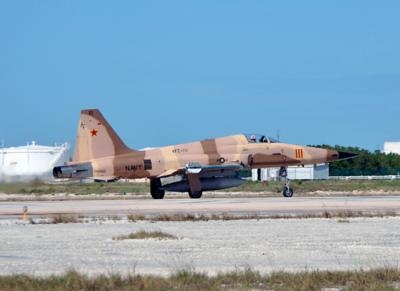Sun, Jun 04, 2023
Aviator Unharmed
An as-of-yet unidentified U.S. Navy pilot was rescued by one of the service’s MH-60S Seahawk helicopters after ejecting from an F-5N training jet some 22-nautical-miles off the coast of Key West, Florida.

The aviator, who was transported to and released from Miami’s Jackson Memorial Hospital following medical evaluation, was assigned to Fighter Squadron Composite 111, known colloquially as the Sun Downers, and based at Naval Station Key West.
U.S. Navy Captain Geoff Hughes stated of the incident: “It’s part of the job. We’re all aware of it. We do everything we can to avoid the situation that he found himself in—but sometimes things happen.”
Captain Hughes expressed gratitude for the quick work of both the Navy’s Key West Search and Rescue unit and the medical staff at Jackson Memorial Hospital.
The Navy’s Sun Downers squadron comprises primarily former F/A-18 Hornet pilots, most of whom are graduates of the service’s famed Strike Fighter Tactics Instructor program (SFTI program)—better known as Top Gun.
The F-5N aircraft is an ex-Swiss Air Force F-5E utilized by the U.S. Navy as an aggressor aircraft. Purchased from the Swiss Air Force between 2006 and 2020, the machines replaced the Navy’s fleet of high-time USN/USMC F-5Es in the adversary role salient to aerial-combat training.

The 31 May mishap marks the U.S. military’s fifth 2023 Class A aviation accident. Such instances denote aircraft damage equal-to-or-greater-than $2.5-million and/or death or serious disability resultant of the occurrence. Over the last decade, the U.S. Navy’s incidence of Class A aviation mishaps has averaged 8.9-per-year.
A spokesperson for Naval Air Station (NAS) Key West confirmed the aircraft’s loss and set forth it is Navy policy to keep confidential the names of pilots involved in on-duty incidents and accidents.
The Navy spokesperson added: "The pilot was evaluated by medical personnel and was released from a local hospital. The safety and well-being of our pilot remains our top priority. The cause of the incident will be investigated."
More News
From 2023 (YouTube Edition): "Ain’t Your Daddy’s Super Cub”—Don Wade Co-owned by Don and Ron Wade—the former of Don’s Dream Machines, a storied >[...]
Pilot-Rated Passenger Reported That The Pilot Did Not Adequately “Round Out” The Landing Flare And The Airplane Bounced And Yawed To The Right Analysis: The pilot state>[...]
Dead Reckoning Dead reckoning, as applied to flying, is the navigation of an airplane solely by means of computations based on airspeed, course, heading, wind direction, and speed,>[...]
Aero Linx: Lake Amphibian Club This website is created and sponsored by the Lake Amphibian Club, to help spread the word about these wonderful, versatile amphibians that can land j>[...]
“I am deeply honored to be sworn in as NASA administrator. NASA’s mission is as imperative and urgent as ever — to push the boundaries of human exploration, ignit>[...]
 Classic Aero-TV: In Praise of Alabamas Patriot Aircraft USA
Classic Aero-TV: In Praise of Alabamas Patriot Aircraft USA NTSB Final Report: Cirrus Design Corp SR22
NTSB Final Report: Cirrus Design Corp SR22 ANN's Daily Aero-Term (12.21.25): Dead Reckoning
ANN's Daily Aero-Term (12.21.25): Dead Reckoning ANN's Daily Aero-Linx (12.21.25)
ANN's Daily Aero-Linx (12.21.25) Aero-News: Quote of the Day (12.21.25)
Aero-News: Quote of the Day (12.21.25)




